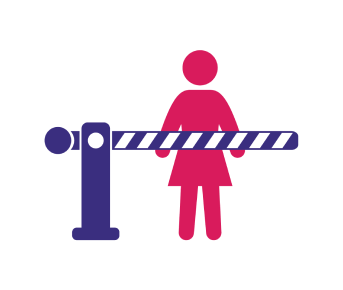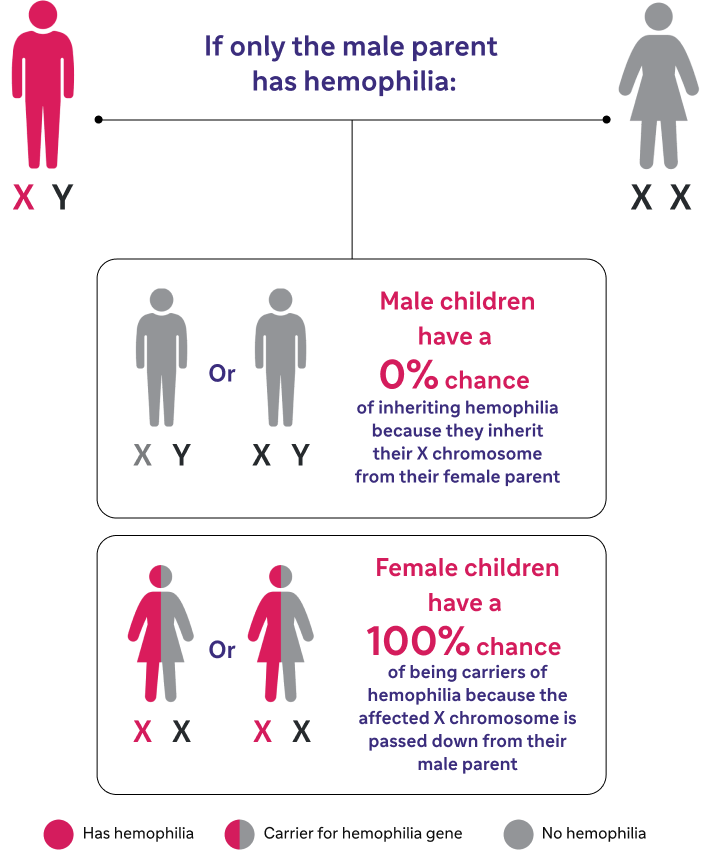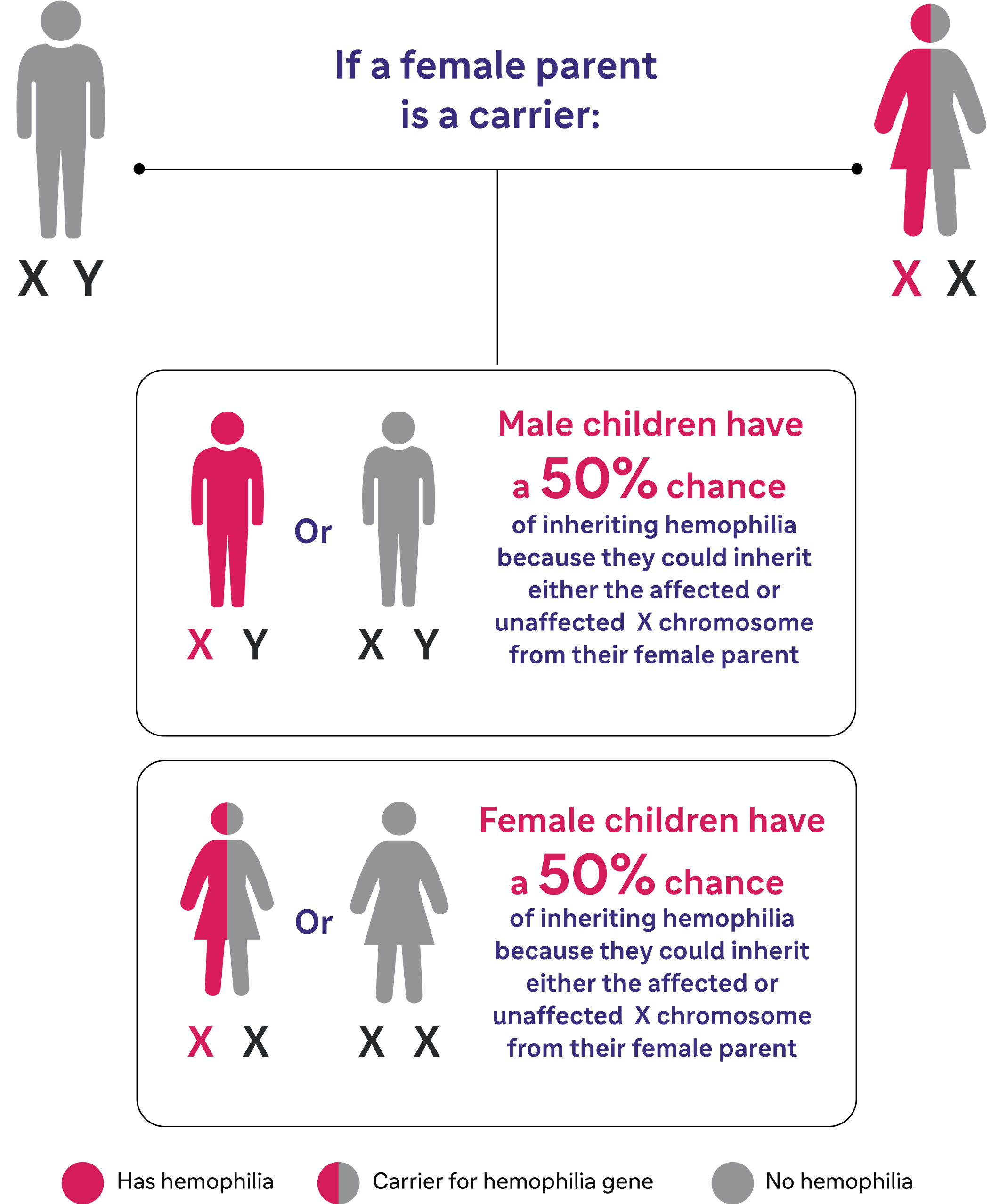Hemophilia in women
There is a misconception that hemophilia only affects men, but hemophilia affects women too.
This page will explore the genetics, diagnosis, signs, and symptoms of hemophilia in women, as well as the importance of factor activity levels in people with hemophilia.
There is a misconception that hemophilia only affects men, but hemophilia affects women too.
This page will explore the genetics, diagnosis, signs, and symptoms of hemophilia in women, as well as the importance of factor activity levels in people with hemophilia.
How hemophilia is inherited
The hemophilia gene is only carried on the X chromosome, and it can be passed down from parent to child.
Males have one X chromosome and one Y chromosome, described as XY, and always inherit their X chromosome from their female parent. Females, however, have two X chromosomes, described as XX, and inherit one from each parent.
The way hemophilia is inherited is therefore different in male and female children and depends on whether it is the male or female parent who has hemophilia.
The hemophilia gene is only carried on the X chromosome, and it can be passed down from parent to child.
Males have one X chromosome and one Y chromosome, described as XY, and always inherit their X chromosome from their female parent. Females, however, have two X chromosomes, described as XX, and inherit one from each parent.
The way hemophilia is inherited is therefore different in male and female children and depends on whether it is the male or female parent who has hemophilia.

Women can be more than “just a hemophilia carrier”
The belief that hemophilia only affects men or that female carriers experience no symptoms are common misconceptions.
Statistics suggest that approximately a third of women who have even just one hemophilia affected gene have low enough factor levels to experience abnormal bleeding.
The belief that hemophilia only affects men or that female carriers experience no symptoms are common misconceptions.
Statistics suggest that approximately a third of women who have even just one hemophilia affected gene have low enough factor levels to experience abnormal bleeding.
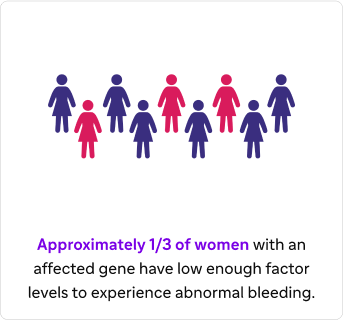
In the US surveillance database, Centers for Disease Control and Prevention (CDC) Community Counts, women account for:
Severe cases of hemophilia
Moderate cases of hemophilia
Mild cases of hemophilia
Diagnosis of hemophilia in females
Hemophilia diagnosis is often missed in women, or women are misdiagnosed because of the common belief that women can only be carriers.
The path to diagnosis for women is, therefore, very different from the diagnosis pathway of men.
Studies suggest that males are diagnosed with hemophilia much earlier in life than females. For example, one study found that, on average, males were diagnosed with hemophilia at 2 days old.* Whereas another study found that, on average, females were diagnosed with hemophilia at 22.6 years old.
Hemophilia diagnosis is often missed in women, or women are misdiagnosed because of the common belief that women can only be carriers.
The path to diagnosis for women is, therefore, very different from the diagnosis pathway of men.
Studies suggest that males are diagnosed with hemophilia much earlier in life than females. For example, one study found that, on average, males were diagnosed with hemophilia at 2 days old.* Whereas another study found that, on average, females were diagnosed with hemophilia at 22.6 years old.

Males were diagnosed with hemophilia at
2 days old

Females were diagnosed with hemophilia at
22.6 years old
Testing for factor activity levels
People with hemophilia have lower levels of the clotting protein Factor VIII in their blood. Therefore, testing for Factor VIII activity levels helps in the diagnosis of hemophilia, as well as establishing the severity of hemophilia.
As approximately one-third of females with an affected hemophilia gene have clotting factor levels of less than 60% of normal, it is important for them to know their factor activity levels to help women and girls understand how it may impact their daily life.
Learn more about Factor VIII activity levels and how they may impact daily life.
People with hemophilia have lower levels of the clotting protein Factor VIII in their blood. Therefore, testing for Factor VIII activity levels helps in the diagnosis of hemophilia, as well as establishing the severity of hemophilia.
As approximately one-third of females with an affected hemophilia gene have clotting factor levels of less than 60% of normal, it is important for them to know their factor activity levels to help women and girls understand how it may impact their daily life.
Learn more about Factor VIII activity levels and how they may impact daily life.
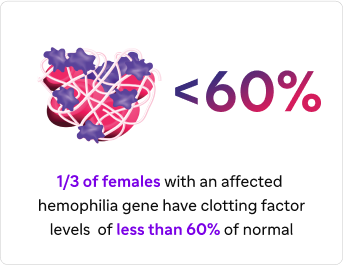
Signs and symptoms of hemophilia in females
- Bruising
- Swelling, pain, and tightness in the muscles and joints, especially the knees, elbows, and ankles
- Symptoms after receiving a shot
- Continued long-term symptoms after an accident, getting cut, losing a tooth, or having surgery
- Frequent nosebleeds
- Blood in urine or stool
Females with hemophilia may also experience:

This can become serious, even life-threatening, especially in women with low factor levels.

Delayed diagnosis or lack of diagnosis can mean that necessary precautions, like avoiding the use of forceps or a vacuum extractor, aren’t considered.

Women in perimenopause are at risk of more bleeding symptoms and may require treatment.
Barriers in the healthcare system for women with hemophilia
Women with hemophilia face several barriers and limitations to receiving the correct diagnosis and, therefore, to being able to live a healthy life with hemophilia. This includes a lack of:
Women with hemophilia face several barriers and limitations to receiving the correct diagnosis and, therefore, to being able to live a healthy life with hemophilia. This includes a lack of:
- Formal testing for factor levels
- Insurance coverage for medications
- Recognition by healthcare professionals
- Information available about the impact of hemophilia and women
- Support programs for women with hemophilia
More needs to be done in the healthcare community to help test for and diagnose hemophilia in women to make sure women receive the best care and support they need in order to live healthy lives.
- Formal testing for factor levels
- Insurance coverage for medications
- Recognition by healthcare professionals
- Information available about the impact of hemophilia and women
- Support programs for women with hemophilia
More needs to be done in the healthcare community to help test for and diagnose hemophilia in women to make sure women receive the best care and support they need in order to live healthy lives.
